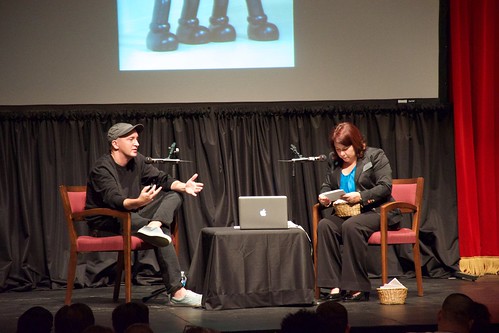KAWS answers community questions at exhibit opening
Brian Donnelly, the artist known as KAWS, matched his large statue in his all-black outfit in the events celebrating the opening of A Shared Space: KAWS, Karl Wirsum, Tomoo Gokita at Newcomb Art Museum.
In contrast to his typically bold art, Donnelly maintained a subdued demeanor as he cracked jokes and answered questions from both Newcomb Art Museum Director Monica Ramirez-Montagut and the audience during “An Artist Interview: KAWS” at Dixon Hall immediately before the opening of the exhibit.
“I kinda just put the work out there and hope for the best,” Donnelly said.
A Shared Space showcases Donnelly’s work in both paintings and sculpture, as well as the work of Karl Wirsum and Tomoo Gokita, two other artists whose works Donnelly admires.
This is not Donnelly’s first time working with Ramirez-Montagut. Ramirez-Montagut has curated other exhibitions featuring Donnelly, as well as written essays and authored books on his work.
Ramirez-Montagut and President Michael Fitts provided opening remarks for An Artist Interview.
“It was interesting to hear a curation perspective along with the artist perspective because I think curation is often left out of the conversation when artists are working,” junior Lilith Winkler-Schor said.
Originally from New Jersey, Donnelly got started in art in graffiti, tagging freight cars with the name KAWS.
He eventually moved to altering advertisements, tagging billboards and breaking into bus shelters. Donnelly managed to alter the advertisements so effectively that passersby did not know whether or not the so-called graffiti was supposed to be there or not.
“It got me thinking about the parallels between advertising and graffiti and communication and how to reach people,” Donnelly said. “It seemed really out of place, and that’s what I like about it.”
From street art, Donnelly expanded into illustration, attending the School of Visual Arts in Manhattan. Today, Donnelly has become a prolific artist dabbling in everything from painting, to clothing design, to toy making. He has had his work displayed in museums and public spaces around the world.
Many of Donnelly’s pieces consist of taking commonly accepted symbols, like the Michelin Man or Mickey Mouse, and altering them into something unique from their original form — like a more formal version of the billboard graffiti from his youth.
“How can you take these things and sort of cross-pollinate your influences to create a new thing?” Donnelly said.
Donnelly avoided assigning meaning to any of his pieces throughout the questioning, disagreeing with Ramirez-Montagut when she attempted to do so.
For his statue, “Companion (Passing Through),” which now sits prominently in front of Newcomb Art Museum, Donnelly said he drew upon its original location in Harbor City, Hong Kong for inspiration. It was situated by a ferry terminal where over a million people would walk past it over the course of a month.
“So I went to the site and I was thinking, like ‘Oh yeah, this is great, but if I was this sculpture and I had to sit here for a month I would be fucking mortified,” Donnelly said. “So that was the sculpture.”
Donnelly has made it a habit throughout his career to take advantage of the opportunities in front of him, whether that be a freight car or the chance to go to Tokyo.
“Brian is really a symbol of the interdisciplinary, entrepreneurial spirit of Tulane,” Fitts said.
A large audience made up of both the Tulane and the New Orleans community showed up for the exhibit opening and the artist interview beforehand. Many of the attendees were creative professionals interested in KAWS’ work.
“I never saw as many people smiling when they listened to the interviews and I don’t think I’ve ever seen the museum as crowded as it is right now,” Fitts said. “It’s great for the museum. It’s great for Tulane. It’s great for New Orleans.”
Your donation will support the student journalists of Tulane University. Your contribution will allow us to purchase equipment and cover our annual website hosting costs.



